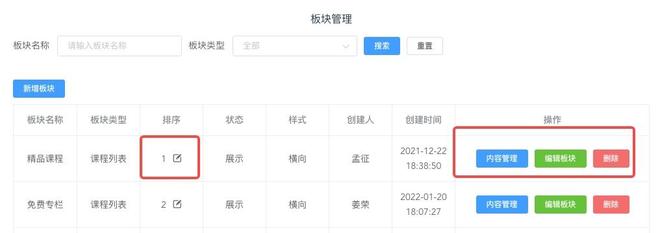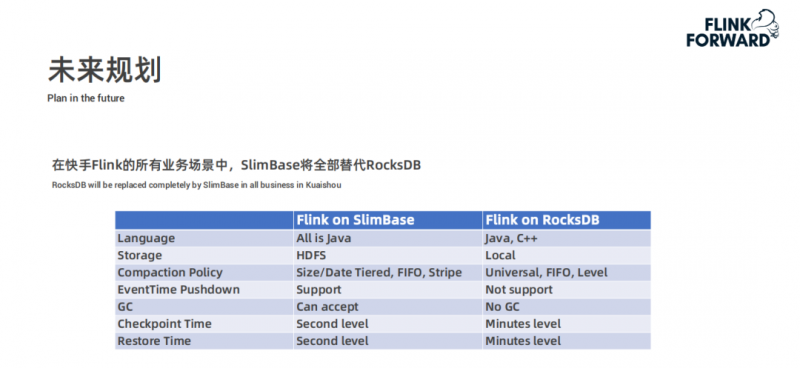作用域插槽的具体应用场景
作用域插槽的具体应用场景
能不能举个具体的例子,便于理解
回答:
可以看看这张图
这个表格的板块类型、排序、创建时间、操作列等,都用到了作用域插槽,代码如下:
<template> <el-table
v-loading="loading"
:data="list"
border
width="100%"
>
<el-table-column
align="center"
prop="name"
label="板块名称"
>
</el-table-column>
<el-table-column
align="center"
prop="type"
label="板块类型">
<template slot-scope="scope">
{{typeMap[scope.row.type]}}
</template>
</el-table-column>
<el-table-column
align="center"
prop="seq"
label="排序"
>
<template slot-scope="scope">
<QuickEdit
:val="scope.row.seq"
:row="scope.row"
label="排序"
:min="0"
:max="999"
tip="输入数字,数字越小越靠前"
@result="handleSave"
/>
</template>
</el-table-column>
<el-table-column
align="center"
label="状态">
<template slot-scope="scope">
{{statusMap[scope.row.status]}}
</template>
</el-table-column>
<el-table-column
align="center"
label="样式">
<template slot-scope="scope">
{{styleMap[scope.row.style]}}
</template>
</el-table-column>
<el-table-column
align="center"
prop="creator_name"
label="创建人"
>
</el-table-column>
<el-table-column
align="center"
label="创建时间"
>
<template slot-scope="scope">
{{$globalFunction.formatTime(scope.row.create_time*1000)}}
</template>
</el-table-column>
<el-table-column
align="center"
label="操作"
width="300"
>
<template slot-scope="scope">
<el-button v-if="scope.row.type === 4" type="success" size="mini" @click="ChildSection(scope.row)">子版块管理</el-button>
<!-- 板块类型 课程列表,且关联类型为商品 -->
<content-manage v-else-if="scope.row.type === 1 && scope.row.assoc_type === 1" :card_section_id="scope.row.id" />
<el-button v-if="[2,3].includes(scope.row.type)" type="success" size="mini" @click="goImageList(scope.row)">内容管理</el-button>
<el-button type="success" size="mini" @click="UpdateSection(scope.row)">编辑板块</el-button>
<el-button type="danger" size="mini" @click="DeleteSection(scope.row)">删除</el-button>
</template>
</el-table-column>
</el-table>
</template>
<script>
export default {
name: "AppSection",
components: {
QuickEdit
},
created() {
this.GetAppSectionList()
},
data() {
return {
loading: '',
submitLoading: false,
list: [],
statusMap: {
1: '展示',
2: '隐藏'
},
seq: null,
}
},
methods: {
async GetAppSectionList() {
const param = Object.assign({}, this.searchModel, this.pagination);
const res = await this.$networkHandler.sendRequest(ApiEnums.GetAppSectionList, param,{},'loading', this);
if (res) {
this.list = res && res.list || [];
}
}
}
}
</script>
因为这些特殊的列并不是直接展示row的字段,而是需要把对应字段传入子组件或者方法中进行处理,这是就会用到slot-scope。
自 2.6.0 起有所更新。已废弃的使用 slot-scope
只要把slot-scope替换成v-slot就可以了。
补充一下那个编辑排序的子组件样式:
回答:
用在动态组件上:
比如有个弹框组件 <module></module>,它有标题,蒙版,和一些弹框样式;在不同的页面有各种各样的需求,有一句话的,有表单,也有可能只有一张图片,你并不希望将所有的可能都定义在组件内部,就用slot放开,想放什么内容进去自己写。
以上是 作用域插槽的具体应用场景 的全部内容, 来源链接: utcz.com/p/937521.html





